ASUS UL50Vt Preview: Factory Overclocked CULV Delivers 7 Hours of Battery Life
by Anand Shimpi & Laura Johnston on September 14, 2009 12:00 AM EST- Posted in
- Laptops
The ASUS UL50Vt: Overclocked CULV
I’m going to preface this next section with an apology. I spent most of last week meeting with AMD about its next-gen GPU (part of the time on an aircraft carrier rented out by AMD to demonstrate the, uh, awesomeness of its new GPU). I ended up only having around two days with the ASUS notebook before this preview had to go live. We’ll have more detailed coverage in the future, but please accept my apologies as this is a very brief preview.

More about what I did on the USS Hornet next week
This is the ASUS UL50Vt, it’s a 15.6” notebook with a 1366 x 768 display.

The 50V is the largest in the UL series, there will also be a 13.3” and a 14” model that are more fitting of the CULV CPU.

The chip used in the UL50Vt is an Intel Core 2 Duo SU7300. A 45nm Penryn derivative the SU7300 has a 3MB L3 cache and runs at 1.3GHz, blech. It’s like a really slow Core 2 Duo E7200. But ASUS does have an ace up its sleeve: Turbo33.
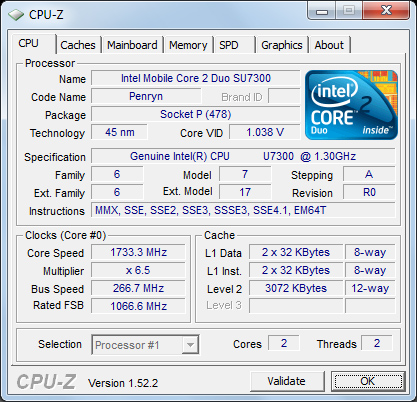
1.73GHz and still lower voltage than most Core 2 Duos
The 33 stands for percent, as in the percent increase in CPU frequency when running in Turbo33 mode. The 1.3GHz SU7300 runs at 200MHz x 6.5 but in Turbo33 mode the FSB gets bumped up to 266MHz and the chip runs at 1.73GHz (266MHz x 6.5).
The performance difference is noticeable, it takes the CULV from slow to an acceptable level of performance. All of the ULxxt notebooks will ship with Turbo33.
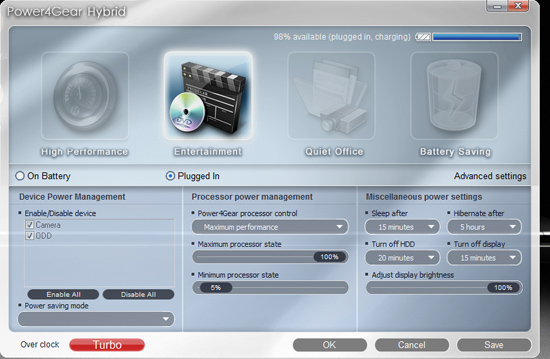
Turbo33 is controlled through ASUS’ PowerGear4 utility. By default the systems ships with it on; very cool.
But what about the impact on battery life? Overclocking is generally frowned upon in notebooks since it, you know, draws more power.
Thankfully the CULV chips start at a lower than normal voltage already, so when overclocked (even while overvolted) they still end up at a reasonable voltage level.
The UL50Vt has a big honking 84Wh battery thanks to the width of the system. The UL30Vt and UL80Vt (13.3” and 14” models) will also have an 84Wh battery, although some models may come with a 63Wh battery.

I only had the UL50Vt for a couple of days so I didn’t have much opportunity to do anything with the system other than use it and run a few numbers. The relevant details are below:
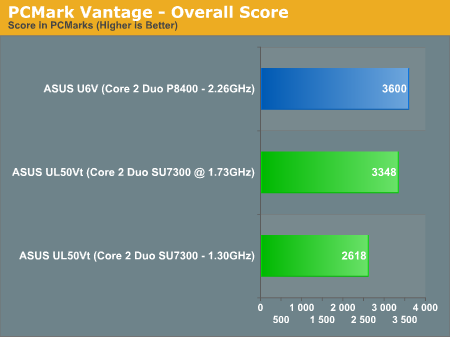
ASUS estimates that with the Intel integrated graphics active the UL50V can last for up to 12 hours. I ran our heavy Flash web browsing test and came up with just under 7 hours of battery life on the UL50V.
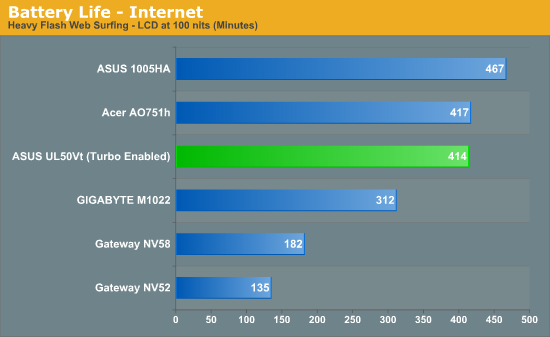
Netbook battery life, but notebook performance
This sort of battery life from an overclocked CULV is impressive. With the same sized battery in the smaller models, I’d expect the same sort of battery life out of them.

The UL50Vt also ships with a GeForce G210M as its discrete GPU. Much faster (and power hungry) than the integrated graphics, ASUS estimates that it’ll knock off about an hour off the battery life. I didn’t get the chance to drain the battery using the G210M but leave your comments below and we’ll address everything you’d like in a full review of the platform.
The notebook looks and feels pretty good. ASUS went with an aluminum top to at least distract you from the plastic elsewhere.

The keyboard looks like Apple’s chiclet keyboard, but the feel is unfortunately not as nice. The tactile response just isn’t as solid as on the Apple.

I’d also take this opportunity to talk about the textured trackpad on the UL50Vt. I’ve seen this used before and while it’s different, I don’t believe it’s ideal. Personally, I’d prefer my trackpad to be as smooth as possible.
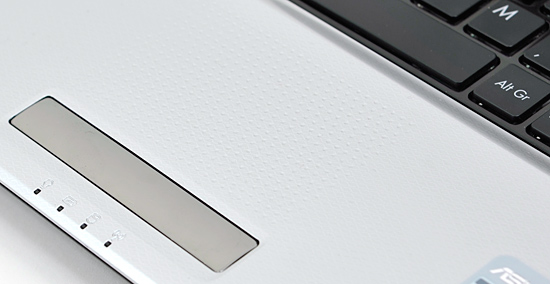
The 1366 x 768 resolution is definitely too low for the 15.6” model in my opinion, but it should be fine on the smaller models. Weight is around 2.1 kg (4.63 lbs); the 13” UL30Vt should be under 3 lbs.
The 15.6” UL50Vt and the 13.3” UL30Vt will retail for $849 once they start shipping at the end of this month. I don’t have full specs on the UL30Vt but this is how the UL50Vt will be configured:

The battery life is the most attractive thing about the UL50Vt, at nearly 7 hours of web browsing (and more if you’re just writing) I can’t complain. Again, the more interesting models will be the 13.3" and 14" CULV systems since they'll actually exploit the portability offered by the processor.
ASUS’ take on CULV is very interesting and I will say that as long as battery life stays high, I don’t care if it takes overclocking to get there.










51 Comments
View All Comments
gstrickler - Monday, September 14, 2009 - link
Why not just use the SU9600 CPU rather than overclock the U7300? Cost is the only reason I can think of. SU9600 has a 10W TDP, runs at the same voltage, and is sped'd @ 1.86GHz. The SU9600 might actually use less power than overclocking since the memory bus would not be overclocked (800MHz vs 1066MHz), and the faster CPU/cache would negate most differences in memory bandwidth.snakeoil - Monday, September 14, 2009 - link
We are still waiting for the lynnfield results without the overclock (turbo overclock).the lynfield review is not valid because it corresponds to an overclocked processor.If we don't get those results we don't know what to do with lynfield.
fitten - Tuesday, September 15, 2009 - link
It corresponds to a processor as it operates in normal mode as it is intended to operate and, indeed, will operate on every machine shipped. By shutting off features of the CPU, you're not benchmarking how the actual processor would be working, you're only chasing some academic discussion about the processor. NO ONE will run the processor in that mode (it'd be stupid to shut off features because they "aren't fair") so any results obtained are useless except for tangential academic discussion.Why not shut off the L2/L3 caches as well or at least make them run at only the size of the competition? That's "fair", right? You might as well make sure that all tests are done with the processors running at the same clock speed... all in the name of "fairness", you know...
Lonyo - Monday, September 14, 2009 - link
Go troll elsewhere please.After reading your comments for other articles, it's clear that the only thing you care about is asking Anand to benchmark a processor with a built in feature disabled.
Maybe next time you should ask to get this system benchmarked with the overclocking disabled? And the underclocking too.
Or maybe you could ask for a review of an HD4870X2 with Crossfire turned off, because Crossfire gives it an advantage over, say, a single GTX280 which doesn't have to run SLI.
Keep your irrelevant and stupid posts elsewhere, if possible on another website.
One request for the review of this is to maybe look at doing a browser test, especially with the built in overclocking feature enabled.
Following on from the other browser test, it would be interesting to see how a higher variability in CPU clockspeeds would change battery life when a variety of browsers are used.
Def. looks like the 13" model could be a nice step up from high-end netbooks if the price is right.
Who would pay $600 for an 11" netbook with 8 hour battery life and poor (relative) performance if you can get a slightly larger 13" laptop with "real" processor, similar battery life, and a minimal increase in size and weight?
MamiyaOtaru - Monday, September 14, 2009 - link
Turbo comes with the processor and requires no user intervention. It's a feature. You are asking for a review of an intentionally gimped processor where a standard feature is turned off. There is no reason for such a review.jonup - Monday, September 14, 2009 - link
Very relavant place for your post.DigitalFreak - Monday, September 14, 2009 - link
"If we don't get those results we don't know what to do with lynfield. "Die?
yacoub - Monday, September 14, 2009 - link
No, but we are waiting for the P55 motherboard round-ups that were supposed to start late last week. :(PotatoMAN - Monday, September 14, 2009 - link
This reminds me of the days of turbo buttons and such when I first started playing with computers (around 80486 days and such). This seems neat, although I would be curious to see if doing simple web browsing makes the system scale back CPU cycles at all? I don't doubt the 7 hours of battery life, but I am a little confused by the intent to go to "turbo" mode then just surf the internet (why would you need to go to turbo mode for this, unless flash playback is bad in regular mode?). Why not go to "turbo" mode and max out the CPU with some Prime95 tests or something? Just a thought... thanks for all the good work and techy journalism AT!XBoxLPU - Monday, September 14, 2009 - link
Why not even look at the SU4100 and the tasks usually done by these typically Netbook segment products. The SU4100 is a dual core CPU that generally improves multi tasking greatly, even for single threaded applications. I would wager that a SU4100 would eat any Atom CPU alive